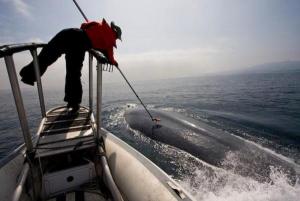By Nicholas St. Fleur
The blue whale — owner of the world’s largest mouth — has some newly discovered prey-catching tricks. In a Jaws-like fashion, the whale ambushes huge patches of prey from below with a powerful 360-degree barrel roll.
The surprising technique may explain how the largest mammals became giants by feasting on the smallest of aquatic creatures, scientists explained during a February 17 symposium at the American Association for the Advancement of Science meeting in Boston.
Unlike other marine vertebrates, rorquals — giant baleen whales that can grow up to 30 meters long and weigh 150 tons — feed by gulping vast volumes of prey-laden water in a process called lunging. The whale’s meal of choice is the small crustacean called krill, which gather together in underwater patches that often span kilometers.
A Cascadia Research Collective scientist uses a long fiberglass pole to place an electronic tag on the back of a blue whale. Credit: Jeremy Goldbogen“You can think of lunging as taking a bite out of a giant super-organism,” said Nicholas Pyenson, paleobiologist from the Smithsonian National Museum of Natural History in Washington, D.C., and a co-author on the study. The team published its work 17 December 2012 in Biology Letters.
When lunging, the whale inverts its tongue and flips down its throat while bursting at 5 meters per second towards a dense patch of prey. The discovery of the barrel roll adds a new twist to the whale’s dramatic dining strategy.
"Imagine holding your breath and accelerating while swallowing this huge volume of water several times,” said postdoctoral researcher Jeremy Goldbogen of the Cascadia Research Collective in Olympia, Washington, who led the study. “It's an extraordinary feeding mechanism that's integrated with the diving physiology of these animals."
Using a "critter cam" attached to a blue whale's back, the Cascadia team took footage as the whale ambushed a krill patch. As shown in this YouTube video, the whale aimed for the krill from below, started its barrel-roll lunge by turning 180 degrees, then opened its mouth and completed a full 360.
To explore the physical details of these whopping meals, Goldbogen and his team used long fiberglass poles to attach high-resolution acoustic sensor tags to the backs of 22 blue whales. The tags resemble waterproof iPhones with apps that measure a whale's acceleration and document its frequent dives for a day or two.
With this data, the team constructed this 3-dimensional model of the lunging technique. The researchers then combined data from the tags with measurements from a whale's skull to estimate that in one gulp, the whale could swallow about 80 cubic meters of seawater — enough to fill a school bus.
Depending on the density of the krill patch, a whale might devour tens of thousands to millions of krill with a single lunge, the team calculated.
“We use this information to understand the energy budgets of these whales, their foraging ecology, and ultimately how these whales evolve these extreme eating methods to support their extremely large body size,” Goldbogen said.
The whale's aquatic acrobatics are not cheap because the high-speed moves create extra drag on the mouth, Goldbogen noted. The added resistance makes the lunge an energy-draining feat, which the whales must offset by swallowing the most krill they can manage.
The positive impacts of these gulps-and-rolls may help explain how the whales' huge bodies evolved — a phenomenon called gigantism. By lunging at densely packed patches of krill, the whales gain more energy than they lose, which supports their larger body sizes, the team deduced.
To probe this connection further, the researchers turned to the fossil record. “We [found] that this lunge feeding mechanism has evolved many times, and there are different lineages of rorquals that evolved these extreme bodies,” Goldbogen said. “So clearly lunge feeding provides an evolutionary pathway to gigantism."
Nicholas St. Fleur is a senior at Cornell University majoring in biology with a minor in communications. His work has appeared in Science and the Cornell Alumni Magazine. He currently heads the science desk at Cornell’s student-run daily newspaper, The Cornell Daily Sun. Follow him on twitter @SciFleur or read his blog at nicholasstfleur.blogspot.com.

